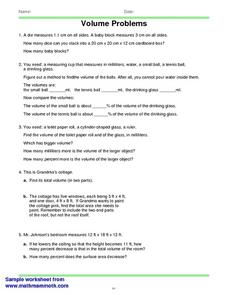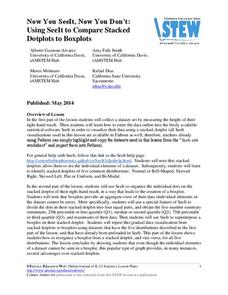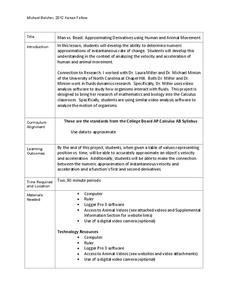Curated OER
Comparing Objects
In this comparing objects worksheet, students check correct answers about what objects in sets are largest, smallest, tallest, shortest, heaviest or lightest.
Math Mammoth
Volume Problems
In this volume problem instructional activity, students determine the volume of various objects. They compare similar objects and determine the percent of increase and decrease of the surface area and volume. This one-page instructional...
Curated OER
Stories from Africa
Students discuss the size of adult African elephants after a demonstration on their height. They try to guess the animal of discussion based on clues given about their size and characteristics. As a class, they try to identify other...
Curated OER
Describing Measurements Guided Lesson
The graphics here aren't the best, but if you are looking to get your students warmed up for a measurement lesson, this may do the trick. First, they use stars as units of measurement for three objects. They have to pay careful...
Noyce Foundation
Which is Bigger?
To take the longest path, go around—or was that go over? Class members measure scale drawings of a cylindrical vase to find the height and diameter. They calculate the actual height and circumference and determine which is larger.
Center for Learning in Action
Properties of Balls
Enhance your states of matter lessons with a hands-on science investigation that compares six different balls' color, texture, size, weight, ability to bounce, and buoyancy.
Curated OER
Short, Shorter, Shortest, Part 2
Can your kindergartners draw a shorter tree? What about a shorter kite string? Reinforce relative size and comparing with a clever learning exercise. It prompts young learners to study a picture and draw a shorter version, and to choose...
Curated OER
A Penny for Your Height
Students investigate measurement. In this fifth/sixth grade mathematics lesson, students explore the relationship between inches and centimeters. Students measure their height in inches or centimeters and convert the measurement.
Curated OER
Sizes Worksheet: Smallest
In this size comparison worksheet, students will examine three groups of pictures and determine which picture in each group is the smallest.
Illustrative Mathematics
Comparing Snow Cones
Everyone wants to have the biggest snow cone possible, so would that be in cone-shaped cup or a more cylinder-style cup? Hungry geometry juniors compute the volume of each in this practical task.
PHET
Fluid Pressure and Flow
This simulation begins with an exploration of water pressure and atmospheric pressure. In the flow portion, scholars reshape a pipe and see fluid dynamics at work. The water tower portion encourages pupils to determine how water...
PBS
Terrific Trees
Engage in a shady activity to practice measurement techniques. Classes venture outside to collect measurements of various trees, using different strategies to measure the height, trunk circumference, width, and crown size. Then they...
Curated OER
Volume of Pyramids and Cones
High schoolers find the volume of pyramids and cones. In this volume of pyramids and cones lesson, learners explore the relationship between the volumes of prisms and pyramids. They investigate the relationship between pyramids and cones.
Exploratorium
Handy Measuring Ratio
Your hand can be a handy tool for measurement. Young mathematicians learn how to estimate the height of objects by applying similarity. They find the horizontal distance from the object where spreading their outstretched fingers results...
Illustrative Mathematics
Banana Bread
Show your future bakers how to choose the right baking pan by calculating the volume of a pan. The resource compares two pans, one with decimal edge lengths and is too small for the recipe and one that may work. Your number crunchers are...
Curated OER
Piles of Paper
Track how much paper their class uses in a week. They will pile their used paper into one place, each day the pile is measured. They make predictions about how much paper they would collect in a month, then recycle the paper.
EngageNY
Average Rate of Change
Learners consider the rate of filling a cone in the 23rd installment of this instructional activity series. They analyze the volume of the cone at various heights and discover the rate of filling is not constant. The instructional...
Curated OER
Romanticism: The Artistic Expression of Liberalism
The epic clash of reason and emotion comes to life in this informative presentation. Detailing the period of Romanticism in 19th century Europe, these slides contain pictures of the most famous pieces of art during this period. Viewers...
Berkshire Museum
The Three Life-Giving Sisters: Plant Cultivation and Mohican Innovation
Children gain first-hand experience with Native American agriculture while investigating the life cycle of plants with this engaging experiment. Focusing on what the natives called the Three Sisters - corn, beans, and squash - young...
Curated OER
Comparing Objects
In this comparison worksheet, students compare objects, checking the one that is the largest, smallest, tallest, shortest, heaviest or lightest.
Baylor College
Your Energy Needs (BMR)
How many Calories one needs on a daily basis is dependent on a number of factors including gender, height, and activity level. In the third of seven lessons about energy and food, young nutritionists calculate the number of Calories...
Statistics Education Web
Now You SeeIt, Now You Don't: Using SeeIt to Compare Stacked Dotplots to Boxplots
How does your data stack up? A hands-on activity asks pupils to collect a set of data by measuring their right-hand reach. Your classes then analyze their data using a free online software program and make conclusions as to the...
Kenan Fellows
Man vs. Beast: Approximating Derivatives using Human and Animal Movement
What does dropping a ball look like as a graph? An engaging activity asks learners to record a video of dropping a ball and uploading the video to software for analysis. They compare the position of the ball to time and calculate the...
Wilson Language Training Corporation
Handwriting Worksheets
Support your pupils as they learn how to write the alphabet, words, and even sentences. The handwriting pages all use the Wilson Writing Grid, in which each line corresponds with a particular letter height and an image (for example, the...

























